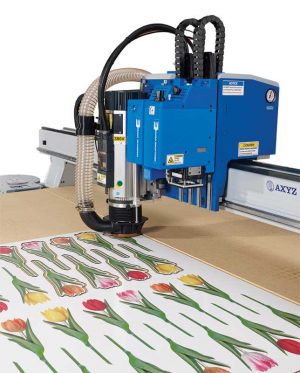Lessons learned

A return on investment (ROI) calculation should begin by determining the number of labour hours and the associated costs with manually cutting and drilling parts, which could have been cut and shaped quickly using router automation.
Every sign shop, including smaller ones, needs to stay ahead of the investment curve if ROI is to meet and exceed expectations. For buyers who have decided to invest in a router, the following 10-item checklist can help one calculate costs and ROI.
- Take time to examine the impact of the machinery on project workflow and manufacturing space.
- Consider additional costs such as the possible need for a larger air compressor,
more electrical work to accommodate the
router, and training staff. - Determine implications for the business such as a possible disruption during installation and training.
- Determine if long-term use of the particular router under consideration will enable the company to achieve future goals, including business expansion, which is one of the most important ROI concerns.
- Demand a business partnership with a provider who can work with the company and help the business flourish without getting in the way.
- Research the quality of the vendor’s technical support and parts replacement.
- All machinery requires constant maintenance, service, and qualified staff to operate. Therefore, it is important to closely analyze how all three will be controlled.
- Be upfront about expectations, and require the same from the vendor.
- Examine the benefits of establishing a partnership with a fully integrated supplier to eliminate potential third-party issues. Having manufacturing support and engineering teams under the umbrella has proven to be better for the business.
- Buy a machine that has the right parts and pieces for long-term growth.
ROI is always based on costs and use. That said, the interconnection of machines means a wealth of data will be collected by today’s CNC routers on a daily basis. As a result, company owners get an up-to-date picture of the real-time ROI status, the machine’s use, and its successful operation.
A business partner who is more than a vendor is an absolute for achieving the maximum ROI. Technological changes and improvements are a given; therefore, it is important to thoroughly study and evaluate the vendor’s ability to provide upgrades integral to business growth.
More importantly, businesses are best served by vendors who are local and can promptly provide service, training, and support. Delays caused by the vendor’s distance can only increase the machine’s downtime and decrease ROI. Parts, advice, and training from the machine manufacturer, while very important, are part of the ROI equation.
The other component is investing in teaching staff to operate and maintain the router properly. Adherence to maintenance protocols should keep the machine operational for many years and substantially reduce the risk of a full stop due to failures from misuse.
Finally, the machinery to be purchased should align with the company’s current and future capacity. This is the best way to improve production workflow, reduce costs, and assure a ROI that justifies the purchase.
Greg Jenkins is vice-president, North American sales for AXYZ, a global manufacturer of computer numerical control (CNC) router machines and knife systems. For more information, visit www.axyz.com/us.





